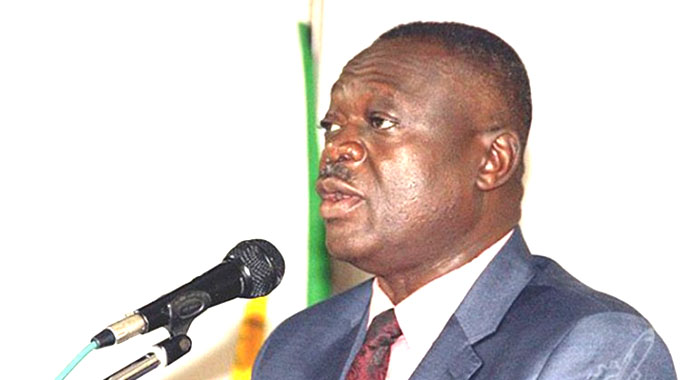Empowering citizens through land ownership

Elliot Ziwira Senior Writer
Zimbabwe is endowed with vast arable land, large reservoirs of underground and surface water (with over 8 000 dams), favourable climatic conditions and an array of rich flora and fauna, which poise agriculture as a key driver in economic growth.
With over 39,6 million hectares of land and complementary agro-climatic conditions, the country can sustain over 23 types of food and cash crops plus a multiplicity of livestock species.
It is because of such an ancestral heritage that the Motherland was colonised when the “Pioneer Column” on the behest of Cecil John Rhodes, hoisted the Union Jack on September 12, 1890 on Harare Hill in Salisbury, and “in the name of Queen Victoria, took possession of Mashonaland, and all other unpossessed land in South-Central Africa that it should be found desirable to add to the Empire” (Martin and Johnson, 1981: xiii).
Through colonial conquest, the indigenes would remain under the settler yoke for close to a century. Both the basis for possession and the flagrant claim that there could be “unpossessed” land in a country with inhabitants, that could simply be usurped because it was “desirable” to do so, are interesting moot points at the level of law and social justice.
Because to Africans loss of land (their mother) equates to loss of spirituality, life and dignity, black people had to engage in protracted struggle against white Rhodesians from 1896 (First Chimurenga) to the late 1970s (Second Chimurenga).
To protect the people’s collective struggle and to uphold its values, after Independence in 1980, the Government of Zimbabwe put in place policy frameworks that would withstand the vagaries of time. To that end, the Ministry of Lands, Agriculture, Water and Rural Resettlement was established to be the custodian of the people’s collective heritage—the land.
At the helm of the ministry is Honourable Perrance Shiri who is deputised by Honourable Douglas Karoro and Honourable Vangelis Peter Haritatos with Dr John Basera as the Permanent Secretary.
Mandate
Inspired by the vision to make Zimbabwe the breadbasket of the SADC and COMESA regions, the Ministry of Lands, Agriculture, Water and Rural Resettlement’s obligation is to promote and sustain a viable agricultural sector through the provision of suitable agricultural infrastructure, mechanisation, technical, administrative and advisory services with the view to enhance productivity and ensure food security.
Functions
The ministry’s purposes are to acquire and transfer land; participate in the formulation, implementation and review of BIPPA land policy in conjunction with the Ministry of Foreign Affairs and International Trade and the Ministry of Finance and Economic Development on an annual basis. The ministry endeavours to routinely establish and maintain a functional land information and management system; develop, review and monitor appropriate land tenure systems for rural agricultural land and other, and enforce the implementation thereof; resolve disputes on farms and allocate land to beneficiaries in a gender sensitive manner on a monthly basis. It also relocates and rationalises improperly settled occupiers on State land on a regular basis, and disseminates information on legal cases and legal provisions so as to comply with all governing legislations.
A peek into the colonial project
The colonial agenda was to keep black people poor by enacting legislation that would deprive them of their land.
The creation of Reserves and Tribal Trust Lands, through the Land Apportionment Act of 1931, amended 60 times to divide land ownership between blacks and whites, that allocated white colonists more than 80 percent of arable land, despite being in the minority (five percent), and blacks 20 percent; was meant to divest indigenous people of their heritage. Whites took the richer parts and condemned blacks to arid, dry and barren areas that could not translate into tangibles for them and their descendants.
With the loss of their land, blacks were also dispossessed spiritually and psychologically, thus they lost the intangibles enshrined therein as well.
Sir Shridath “Sony” Ramphal, Commonwealth secretary-general (1975-1990), who was the Patriotic Front leaders Robert Mugabe and Joshua Nkomo’s advisor at the Lancaster House Conference in London in 1979, revealed how the land issue has always been a thorny one.
In an interview with Gugulethu Moyo and Mark Ashurst for their book “The Day After Mugabe”, he maintains that the Zimbabwean contestation has always been “about land in the beginning”, “during the struggle”, and has “remained about the land” (“New African”, 2007/08:4).
Sir Shridath couldn’t have put it in a better way because the so called “crisis” that has become synonymous with the nation State of Zimbabwe stems from the tangible and intangible heritage that come with ownership of the land.
The post-2000 Fast Track Land Reform Programme only precipitated a situation that was in place since 1890, which created “two nations in this country since 1890—the African nation and the European nation’ (Chigwedere, 2001: vi).
Since then, land has been a contestation of birthright based on conflicting nationalisms, with the European nation using legality to claim ownership, when in the first place it got the land through conquest and not the rule of law; and the African nation, on the other hand, seeking social just to reclaim the key to the livelihood routes its citizens had lost for close to a 100 years.
Colonists benefited from the illegality of the Rudd Concession of 1888 and the 1891 Lippert Concession. At the level of law both concessions were void.
First, the Judicial Committee of the Privy Council of the British House of Lords, the highest court in the British empire, in 1914, ruled that the Lippert Concession “as a title deed, is valueless” and that “the company’s (BSAC) occupation, whatever it rested on, did not rest on the Lippert Concession” (Chigwedere, 2001:22).
The Committee condemned the BSAC’s claim to the land through an illegitimate document, declaring that “recognition could give no title where none existed already” (ibid). From the ruling, Chigwedere (2001:22) maintains that the BSAC’s claims “to land rested on nothing”, therefore, the land was ruled to belong to neither the “company nor to the settlers but to the crown” because what the Company had done in Rhodesia “was done in the name of the Crown” (Chigwedere, 2001:22). As an agent of the Crown, the BSAC was to be compensated for its deficits.
Now the issue of legality gets curious when read against Chigwedere’s observation that “arising from this judgment: Britain admitted our land was illegally seized and distributed” (ibid). By admitting through its own justice system that the occupation of Matabeleland and Mashonaland was both illegal and improper, and accepting responsibility for the BSAC’s mischiefs in the country, Britain makes a clear point at the level of both law and social justice.
The second issue refers to Rhodes’ imposition of hut tax on Africans, which raised another interesting point at law, as it glossed over colonial injustices in the name of modernity. In reference to the illegality of hut tax, Rhodes, then Prime Minister of the Cape was advised by his Attorney General, W.P Schreiner that taxing Africans was tantamount to “taxing the real owners of the soil for the support of a Government which is in the country only by permission from the native sovereign” (ibid:19).
In concurrence, the Imperial Secretary at Cape Town said: “The natives are probably in law and equity the real owners of the land they occupy and it would be difficult to charge them tax for the occupation of their own lands” (ibid).
Chigwedere (2001: 33) maintains that between 1893 and March 1896, the Ndebele lost “anything from 100 000 to 200 000 cattle” to settlers, which were administered by “The Loot Committee” (ibid.29).
Cattle stolen from the Shona and the Ndebele were used to start the Cold Storage Commission, and “these were the cattle borrowed by commercial farmers to start their own herds” (Chigwedere, 2001:32).
Through wanton disregard of the same tenets of justice, colonialists went on to plunder Africans’ heritage clearly aware that it was both legally and morally wrong.
Defying colonial Lazarus: Land reforms (1980-2000)
After a protracted liberation struggle, the Lancaster House Agreement of 1979, gave the nation of Zimbabwe a Constitution at birth on April 18, 1980, which “embodied a series of compromises over minority rights, in particular on the future of land ownership” (Raftopoulos and Mlambo, 2009:xxviii), thus, guaranteeing white capital glory in the sunshine.
Correcting colonial imbalances became the Government of Zimbabwe’s immediate concern, therefore, legislation had to be enacted to achieve that. Of the 39,6 million hectares of land in the country, about 42,1 percent is utilised for agriculture of which 365 000 is suitable for irrigation. Hence, this land had to be redistributed in line with the revolutionary tenets that drove the liberation struggle.
The ZANU policy statement of August 21, 1963, committed the party to, among other resolutions, “repeal the Land Apportionment Act, the Land Husbandry Act, and to replace them with a new Land Redistribution Law; to create a National Land Board to effect an equitable redistribution of land and abolish the destocking of cattle” (Zvobgo, 2017:11).
Another condition that compromised the noble plan of the new nation’s Government set by the Zimbabwe-Rhodesia delegation was that where land was compulsorily acquired, “the white farmers who were dispossessed should be paid full and fair compensation to be deposited wherever they wanted, in a currency of their choice” (Maruma, 2007:6).
After much persuasion from the American chief diplomat at the United Nations, Andrew Young, the British government pledged to provide financial assistance for land reform under a willing-seller-willing-buyer basis, which pledge was later reneged on (Chigwedere, 2001), thus, heightening the contestation of heritage.

Deputy Minister Haritatos
Although “solid assurances were recorded in the documents of the conference and notified to all commonwealth countries” (“New African”, 2007/08: 5), no particular sum was specified, which could make it difficult to enforce compliance in future. According to Sir Shridath, there was no mention of a contribution on the part of the Zimbabwean Government.
To honour its pledge to the people of Zimbabwe, between 1981 and 1987, the Government resettled 62 000 families on two million hectares of land bought on a willing-seller-willing-buyer basis. During this period, the United Kingdom under Margaret Thatcher provided 44 million pounds for resettlement schemes (Chung, 2006).The UK government would later renege on its Lancashire House pledge after Thatcher’s departure in 1990. This compromised resettlement efforts, although more reforms were effected in the 1990s.
Around the late 1990s, the colonial agenda in place since 1890, started rearing its ugly head. Everything to do with upsetting the status quo on land ownership was shot down. It is, therefore, worth noting that Claire Short’s letter on behalf of the UK repudiating responsibility to their own historical blunders, claiming that she was “Irish”, and were also “colonised and not colonisers”,was “an inimitable mixture of shamelessness and sanctimony” (Nathaniel Manheru in “New African”: 2007/08:27).
Denying responsibility was meant to create fertile grounds for rebuke on the post-2000 Fast Track Land Reform Programme. However, against all odds the Government of Zimbabwe embarked on the journey to open up opportunities for citizens through land ownership.
The post-2000 Land Reform Programme transformed the structure of land ownership, as more Zimbabweans got access to agricultural land. The colonial structure which gave about 6 000 commercial white farmers access to large swathes of arable land was done away with. Now smallholder farmers occupy about 70 percent of the land, with many medium to large-scale commercial farmers utilising smaller landholdings.
According to the Ministry of Lands, Agriculture, Water and Rural Resettlement’s “National Agriculture Policy (2018-2030): First Draft” (2018) report, the reduction of large-scale commercial farms benefited 145 000 new A1 farmers, 18 000 new A2 farmers by 2018, bringing the total number of smallholder farmers to approximately 1,3 million.
The report reveals that the number of large-scale farmers came down from 6 000 to 4 500. Over a million communal farmers rely on rain-fed agriculture, with 70 percent of them sustaining livelihoods on less than two hectares.
Agriculture remains a key component in Zimbabwe’s economic development matrix as it creates employment and reduces poverty. The report indicates that agriculture contributes 15-18 percent of Gross Domestic Product (GDP), 23 percent to total formal employment, and offers livelihoods to close to 70 percent rural citizens (54 percent of them women).
About 63 percent of industrial raw materials, and 60 percent of manufacturing value addition come from agriculture. In export earnings, agriculture enjoys a 30 percent share. Of the 31 industry clusters in Zimbabwe, 15 rely of agriculture for feedstock. In addition, a third of the formal labour force is supported by agriculture-related employment.
About 64 percent of agricultural GDP come from maize (14 percent), tobacco (25 percent) and cotton (25 percent).
Beef and fisheries provide 10 percent, and 24 percent comes from sheep, goats, pigs, poultry and ostrich. Tobacco, cotton, sugar, horticulture, tea and bananas jointly account for 40 percent of national exports value.
Agriculture, therefore, is crucial in economic development, human capital growth and guaranteeing of national food security.
Productivity, irrigation and drought mitigation
Mindful of the fact that availing land may not be an “endgame”, but certainly a good start to the “game” of reclaiming the Zimbabwean people’s heritage—the land, the Ministry of Lands, Agriculture, Water and Rural Resettlement relooked into previously existing policies with the view to align them with changing trends in agriculture, mechanisation and human growth.
Productivity becomes key if farming is seen as a business, and not just subsistence cropping. For that to happen the ministry constantly looks into ways of developing agricultural skills, provision of inputs and encouraging mechanisation.
Since the 1990s Zimbabwe operated without an up to date Comprehensive Agricultural Policy, relying on the “Zimbabwe Agricultural Policy Framework: 1995 to 2020”, formulated in 1994.
Alive to the need to keep up with shifting trends, , the Ministry of Agriculture, Mechanisation and Irrigation Development (MAMID), now, Ministry of Lands, Agriculture, Water and Rural Resettlement (MLARR), in collaboration with the Food and Agriculture Organisation (FAO) and other stakeholders commenced a process to update the 1994 framework.
Subsequent to that, a “Comprehensive Agricultural Policy Framework” draft was completed in April 2012 to address concerns of crop and livestock production, marketing and trade. The Policy Frame, is, however still to be implemented.

Deputy Minister Karoro
In tandem with the Climate Policy and Agricultural Gender Policy among others, the National Agriculture Framework (2018-2030), seeks to offer guidelines on investments and sector strategies to sustainably transform the agriculture sector.
Efforts are being made to grow the livestock sub-sector, which contributes 19 percent to the agricultural GDP. The sub-sector has been burdened by macroeconomic challenges and diseases such as Tuta Absoluta and Theileriosis (January disease) in cattle.
In colonial Rhodesia blacks did not have access to technical and mechanical training colleges. Agricultural colleges were the preserve for whites. Now Zimbabwe boasts of eight agricultural colleges, and 13 State universities across the country offering agricultural training at graduate and postgraduate levels.
The eight agricultural colleges produce about 2 000 graduates per year (diploma and certificate levels), trained in the areas of: crop and livestock production, commercial farming, animal health, meat and livestock classification; and disease control.
There are also private colleges complementing Government efforts, particularly in courses covering export commodities.
To keep pace with technological drifts in agriculture which are crucial in mechanisation of the sector, upgrading programmes have been started at Chibero, Esigodini, Gwebi, Mlevu and Rio Tinto colleges. Programmes such as the Young Commercial Farmer Training at Kushinga Phikelela National Farmer Training College are crafted to arm students with hands-on skills in agriculture.
Since Independence in 1980, the Government, in conjunction with international donors launched various input support programmes to smallholder farmers in rural areas. The schemes facilitated farmers’ access to producer markets.
The programmes included the Presidential Well Wishers Input Scheme, Winter Input Scheme and the Command Agriculture.
Agriculture cooperatives, instituted since 1980, have contributed to the sector in a big way in terms of employment, poverty mitigation and food security.
Presenting a Ministerial statement in the National Assembly on July 21, 2016 on the state of cooperatives in Zimbabwe, the then Small and Medium Enterprises and Cooperatives Minister Sithembiso Nyoni revealed that there were 194 registered agricultural cooperatives since 2009.
Hurungwe Cooperative Union has been the most impressive as it managed to deliver 534 791 tonnes of maize to the Grain Marketing Board (GMB) in 2013 alone.
To mitigate the impacts of drought, the ministry has been advocating irrigation schemes, use of solar energy, mechanisation and a shift towards small grains.
In 2019, the International Crops Research Institute for the Semi-Arid Tropics (ICRISAT) announced that they were relocating to Zimbabwe to invest millions of dollars towards the modernisation of Matopos Research Station.
ICRISAT has always assisted small grains farmers through Matopos, but the organisation’s participation had been hamstrung by its move to Malawi and Ethiopia.
A well-funded and human-capitalised Matopos Research Station will not only ensure food security for the country, with emphasis on small grains like sorghum, millet, pearl, groundnut, chickpea and legumes, but will also keep poverty at bay through development of rural communities.
With 365 000 hectares of total arable land in Zimbabwe suitable for irrigation, the need arises to invest in irrigation schemes.
In March, 2020, President Mnangagwa commissioned Nyakomba Irrigation Scheme in Nyanga.
The US$15 million project started in 2015 was funded under the Japanese Grant Aid.
The Ministry of Lands, Agriculture, Water and Rural Resettlement’s Department of Irrigation and the Japan International Cooperation Agency (JICA) were involved in the rehabilitation and development of the facility.
A modernised agriculture sector will bring national Vision 2030 to citizens’ doorsteps.
Political freedom alone without ownership of the means of production adds up to nothing, which is why the recent move by the ministry to rationalise the sizes of individual farms countrywide, is apt as it will go a long way in ascertaining that Zimbabweans equally benefit from their ancestral heritage — the land.
As Zimbabwe turns 40 on April 18, 2020, there is no better way of celebrating the milestones thus far achieved than reflecting on the essence of the land as a collective heritage.









Comments